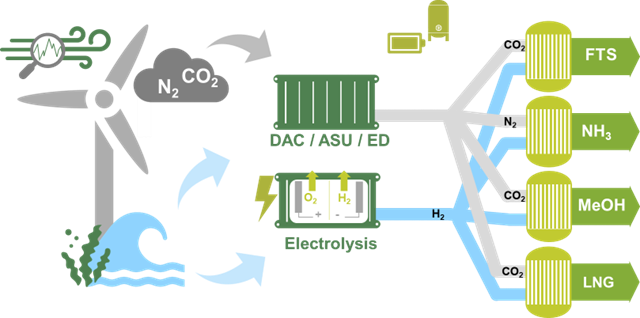Additive Manufactured distillation columns – Manufacturing, Post Processing and Experimental Characterization
- contact person:
Background:
The project H2Mare focuses on the production of green hydrogen at sea using wind energy rather than using grid lines to connect to an H2 production system on land. Since the output of an offshore wind turbine is generally higher than that of the onshore turbine, the excess energy is used for H2 production. The main idea is to integrate the wind turbine into an electrolyser and therefore produce a huge advantage which led to the idea of producing further downstream products like green methanol and green ammonia.

Methanol production involves the distillation of the Methanol-water mixture in the later steps. This case is especially complicated because of offshore conditions such as wave motion and the necessity for compact size. Additive Manufacturing is the key to bringing modern solutions to such complications. Former researchers at IMVT have developed a helical distillation column which has a very good separation efficiency. The design is optimized for separating most hydrocarbon mixtures. The institute also has a distillation test rig for experimentally testing the 3D-printed columns.

The pictures above are the available 3d printing facilities available at IMVT. You can use your knowledge and imagination to build the distillation column and test rig necessary for your research.
Your tasks:
1. Manufacturing of various distillation columns using the 3d printers available.
2. Post processing of the manufactured units and Quality control.
3. Distillation experiments on various 3D printed units using a Methanol-water mixture.
4. Calibration of Methanol concentration and Analysis of samples using FT-IR spectroscopy.
5. Modification of the existing distillation column design in relation to offshore conditions.
6. If necessary experiments setup needs to be modified with the control system.
Requirements:
1. You have a background in Chemical/Process engineering or Mechanical engineering.
2. You have experience or understanding of separation techniques, especially Distillation.
3. You have a basic knowledge of CAD software like Autodesk Inventor.
4. You are expected to have experience with 3d-printing.
5. More interest and experience in Laboratory work.
6. The work is expected to be done in English.
Please send your CV and Cover letter to vignesh.jayavelu@kit.edu if you are interested in the topic.
Start Date: 5 weeks after confirmation
Professor: Prof. Dr. Christoph Klahn
Supervisor: M.Sc. Vignesh Jayavelu
